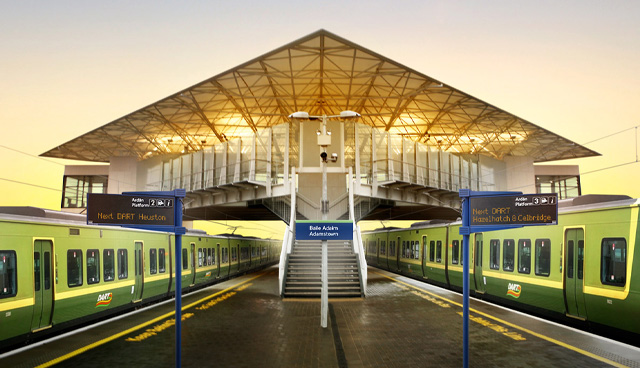Real progress on rail’s role in our sustainable future

Support for a stronger rail network is being seen in policy and investment decisions says Jim Meade, Chief Executive of Iarnród Éireann.
In parallel with our management of Iarnród Éireann’s network and services through the Covid-19 crisis, we have been focused on our post-Covid future. This is to ensure that our railway is at the heart of a sustainable future for Ireland, with policy at European, national, and regional level prioritising sustainable mobility and decarbonisation, to support our environment, economy, and society.
If anything, the support for a sustainable transport network which existed across policymakers, regulatory bodies, and our wider communities and businesses, has strengthened through the crisis. This means that, with the progress made on our ambitions for our rail service and network over the past 12 months, we are well positioned to ensure rail is the backbone of such a network.
There has never been a time when we have such a unique opportunity to facilitate a more sustainable pattern of travel, development, and economic activity, to meet climate action goals at national and international level and improve quality of life for generations to come.
DART+ Programme
Before Covid-19, in 2019, we in Iarnród Éireann carried a record 50.1 million passengers on our services, across Intercity, DART and Commuter, and trends were set to see yet more record highs successively this year, and in the years to come. Internationally however, in countries like New Zealand who have reopened practically fully, we are seeing stronger recovery in public transport patronage, meaning the importance of building our network capacities remain.
At the heart of our plans is DART+, supported by the Irish Government under the National Development Plan.
Put simply, this investment will allow more trains to operate on all routes on our network, by building the capacity of the most congested sections in the Greater Dublin area.
It will see:
- the electrification of the Maynooth, Hazelhatch and Drogheda rail lines;
- associated works such as the elimination of level crossings on the Maynooth line;
- infrastructure works to allow more trains to operate, including at Connolly and Docklands;
- integration with other public transport modes including proposed MetroLink and BusConnects programmes;
- a major expansion of our fleet, with up to 750 electric and hybrid train carriages to be ordered, resulting in almost 80 per cent of journeys on our network being delivered under electric power;
- all leading to a doubling of the carrying capacity of the Greater Dublin Area network.
Public consultation on DART+ West (Maynooth/M3 Parkway) and DART+ South West (Hazelhatch to Heuston) is well underway, with planning for DART+ Coastal (Drogheda to Greystones) also having commenced.
Crucially, the order for the fleet set to be at the heart of our service over the coming decades is now just months away.

“Investment in infrastructure in the Dublin area will not only benefit Dublin commuter belt services, however. It will grow our ability to operate services right around the country. We are also ambitious to see journey time improvements on national routes, and targeted line speed improvement works are already taking place.”
As well as ensuring our new fleet is more sustainable, we have also begun a programme to convert our existing Intercity railcar fleet to diesel electric operation, reducing emissions, fuel usage, costs, and noise.
Improving access to services for all customers will also be at the heart of our investment plans. Accessibility for mobility and sensory impaired customers will be a principle of all station and fleet improvements, and our largest ever lift renewal programme is underway. Investment in park and ride facilities, and customer information will also make our services easier to access and to use.
National network
Investment in infrastructure in the Dublin area will not only benefit Dublin commuter belt services, however. It will grow our ability to operate services right around the country. We are also ambitious to see journey time improvements on national routes, and targeted line speed improvement works are already taking place.
Regional cities
We have also seen huge progress in our plans to strengthen the role of rail for our regional cities.
As part of the Government’s National Recovery Plan, €185 million is to be invested in the Cork commuter rail network, under the EU-funded Recovery and Resilience Plan.
The funding will allow Iarnród Éireann to increase the Cork commuter rail network’s capacity to deliver DART-type frequency, through three major elements:
- Double-tracking Glounthaune to Midleton;
- Developing a new through platform at Kent Station for through running for Mallow to Midleton/Cobh; and
- Resignalling the Cork commuter network.
The announcement also made clear that the next steps after this funding will be to electrify the Cork commuter network, and develop new stations, as planned under the Cork Metropolitan Area Transport Strategy (CMATS).
In Galway, funding under the Urban Regeneration Development Fund (URDF) for the western region includes two significant projects which will improve frequency, integration, and facilities for rail services to and from Galway city.
Investment of €9.3 million will include a 1km passing railway loop at the existing Oranmore Train Station, including an additional platform and associated infrastructure, which will allow the busy commuter link between Athenry and Galway to grow, in advance of our ambition for full double-tracking of the section in the future.
Ceannt Station in the heart of Galway city will benefit from a major €40.3 million Galway City Council Transport Connectivity project. It includes Ceannt Quarter Regeneration, a Brownfield regeneration scheme comprising of redevelopment of Ceannt Station. It will result in an integrated transport hub in the heart of Galway City Centre.
Waterford’s Plunkett Station will be relocated to be part of an integrated transport hub under plans to develop the city’s North Quays. In Limerick, the completion of the city’s own transportation hub centred on Colbert Station will also boost services, and the Limerick Shannon Metropolitan Area Transport Strategy will assess the opportunities provided by the network of rail lines around Limerick City.
Rail freight and Rosslare Europort
New rail freight business, with XPO Logistics between Ballina and Waterford, and major expansion of direct services between Ireland and the European Continent through Rosslare Europort, for which Iarnród Éireann is Port Authority, have also been delivered since the start of 2021.
Rosslare Europort’s status as Ireland’s gateway to Europe has been confirmed post-Brexit, with 17 services operate each way to and from Europe each week, making it Ireland’s foremost Ro-Ro port for continental services.
We will build on Rosslare’s critical role for Ireland’s economy, ensuring efficiency and sustainability in our operations, through the port’s Masterplan, investing over €40 million in port facilities, infrastructure, and systems.
The direction of travel, and acceleration of momentum, is clear. Our journey to our sustainable future is en route to a destination which will benefit our country, our environment, our communities, and our society as a whole, and everyone is welcome on board.
T: (01) 8366 222
E: IENews@irishrail.ie
W: www.irishrail.ie






